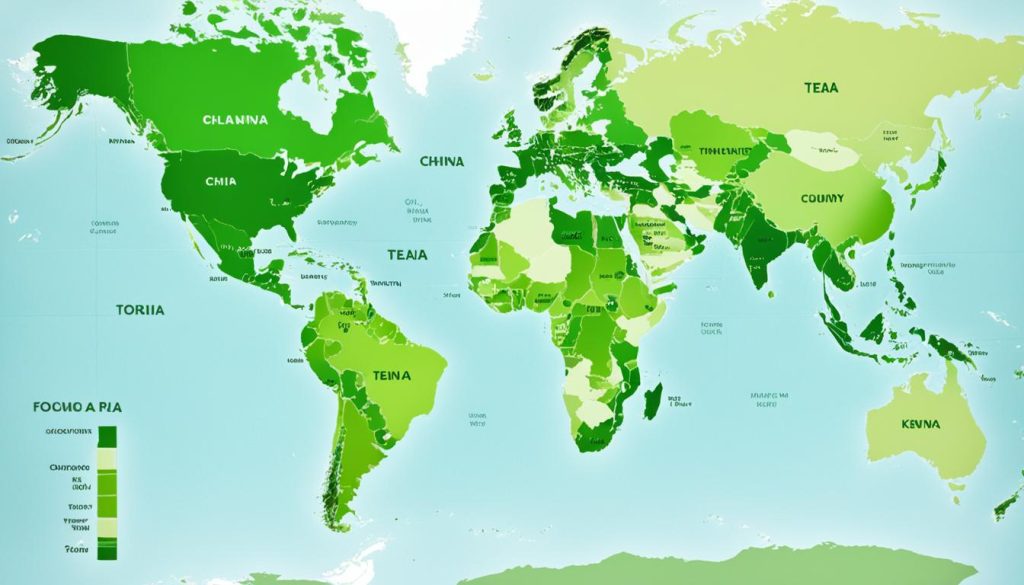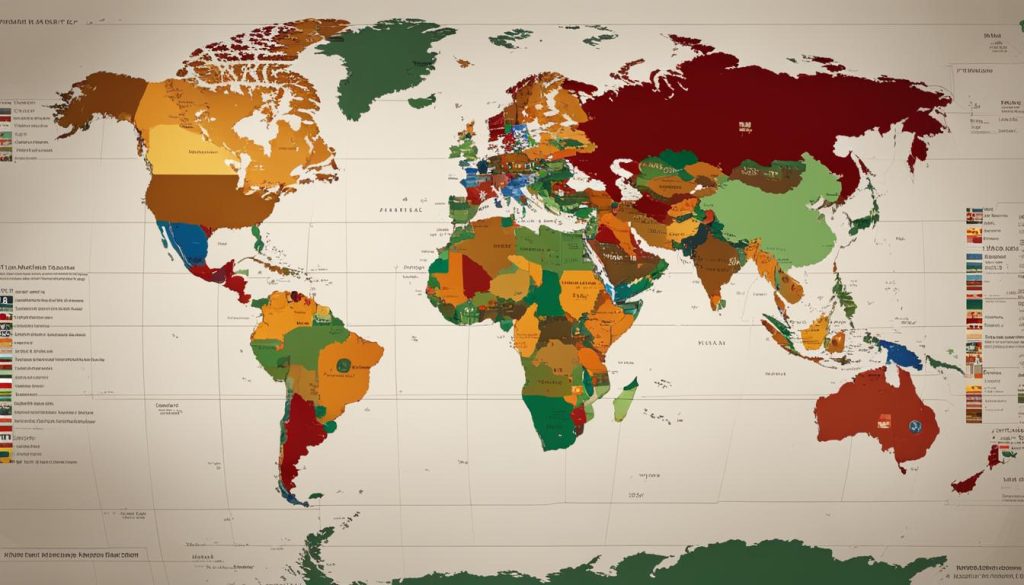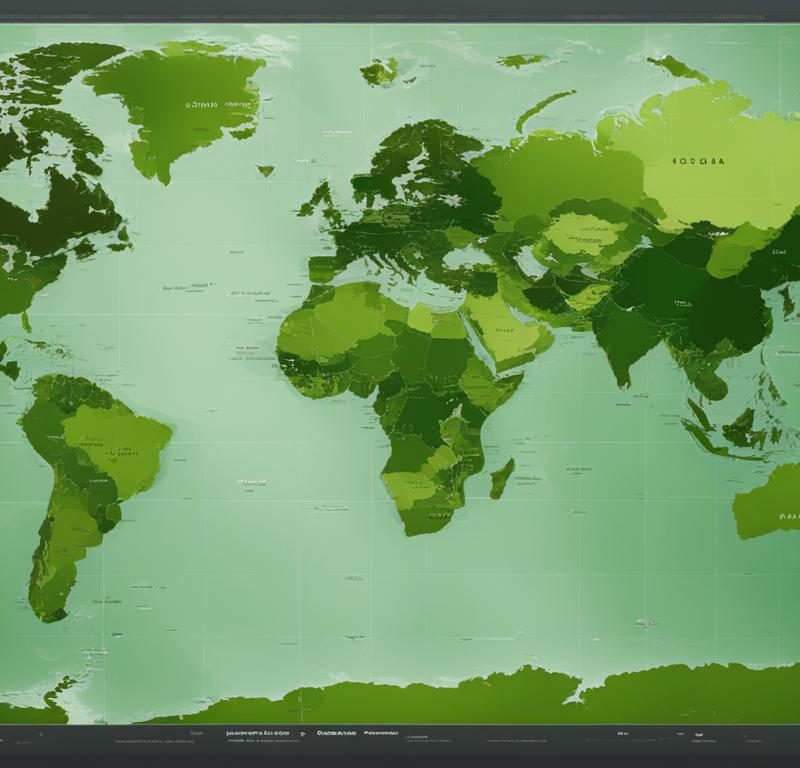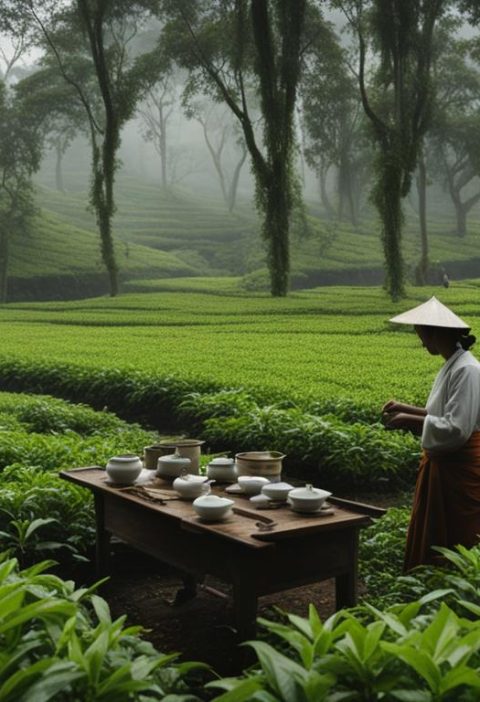When it comes to tea, prices can vary greatly depending on the country of origin. For those who enjoy a good cup of tea, comparing costs of tea from different countries can be an enlightening experience. It allows us to understand the factors that contribute to the variations in prices and make informed decisions about our tea purchases. In this article, we will explore the international tea prices and conduct a global tea cost analysis, highlighting the tea cost differences by country. By the end, you will have a clearer picture of the tea pricing comparison and the tea cost variance between nations.
Key Takeaways:
- Tea prices can vary significantly by country due to factors such as production costs, import/export tariffs, and supply and demand dynamics.
- China, India, Kenya, and Sri Lanka are the top tea-producing and exporting countries, accounting for around 75% of global output.
- Understanding the global tea market and comparing costs can help us find the best deals and choose tea that suits our preferences and budget.
- Tea prices are expected to rebound in the near future, so staying updated on market trends is essential for making informed purchasing decisions.
- Exploring different tea varieties from various countries can be an enjoyable and educational experience, offering a glimpse into different tea cultures and flavors.
Factors Affecting Tea Prices
Tea prices are influenced by several factors that shape the global tea market. Understanding these factors can provide valuable insights into the dynamics of tea pricing across different countries.
One of the key factors influencing tea prices is the overall global market trends. Market conditions and dynamics can impact the demand-supply balance and consequently influence the prices of tea. For example, if there is a growing trend of tea consumption and limited production, it can lead to an increase in tea prices.
Supply and demand dynamics play a crucial role in determining tea prices. Fluctuations in production levels and consumer demand can directly impact the prices of tea. When the supply of tea exceeds the demand, it usually results in lower prices. Conversely, when demand outpaces supply, it can lead to higher tea prices.
The production and consumption patterns of tea also contribute to price fluctuations. The volume of tea produced by different countries, as well as their consumption habits, can influence the overall tea market. For instance, countries with higher tea production may have a competitive advantage in terms of pricing compared to those that rely on imports.
Export and import volumes are additional factors that affect tea prices. The balance between tea exports and imports in different countries can impact pricing. Countries that heavily rely on imports may experience higher tea prices due to transportation costs and trade policies.
Influencing Factors Summary:
| Factors | Impact |
|---|---|
| Global Market Trends | Affects demand and supply balance |
| Supply and Demand Dynamics | Fluctuations in production and consumer demand |
| Production and Consumption Patterns | Volume of tea produced and consumed |
| Export and Import Volumes | Balance between tea exports and imports |
Top Tea Exporting Countries
When it comes to global tea trade, there are several countries that stand out as the largest tea exporters and top tea-producing nations. These countries have a significant share of international tea sales and have established themselves as leaders in the industry. Let’s take a closer look at some of the leading tea exporting countries:
1. China
China, known for its rich tea culture, is the largest tea exporter in the world. The country boasts diverse tea varieties and has a long history of tea production. Chinese tea exports cater to both traditional and specialty markets, making it a dominant player in the global tea trade.
2. Kenya
Kenya has emerged as a major player in the tea industry, ranking second among the top tea exporting countries. The country’s unique climate and favorable geographical conditions contribute to the production of high-quality teas. Kenyan teas are highly sought after for their brisk, flavorful profiles.
3. Sri Lanka
Sri Lanka, formerly known as Ceylon, is renowned for its quality tea production. The country is well-known for its black teas, which are favored for their distinct flavor and aroma. Sri Lankan teas are highly regarded in international markets and contribute significantly to the global tea trade.
4. India
India, with its diverse regional tea gardens, is a prominent tea-producing nation. It is famous for its Darjeeling, Assam, and Nilgiri teas, which have distinct characteristics and are highly valued by tea enthusiasts worldwide. Indian teas have a strong presence in the global tea market.
5. Poland
Poland has emerged as a notable tea-exporting country, known for its specialty and herbal teas. The country has seen significant growth in the tea industry, offering a wide range of unique and innovative tea blends. Polish teas have gained recognition for their high quality and distinctive flavors.
These top tea-exporting countries play a crucial role in the global tea trade and contribute to the diverse tea options available to consumers around the world. Other notable tea exporters include Germany, Japan, the United Kingdom, and Vietnam, each offering their own unique tea varieties.
To get a visual representation of the top tea exporting countries, take a look at the table below:
**Table: Top Tea Exporting Countries**
| Country | Ranking |
|———|———|
| China | 1 |
| Kenya | 2 |
| Sri Lanka | 3 |
| India | 4 |
| Poland | 5 |
Tea Production and Consumption Patterns
In this section, we will explore the current patterns of tea production and consumption worldwide. Understanding these trends is essential for tea enthusiasts, businesses, and policymakers, as it provides valuable insights into the global tea market.
Global Tea Production
Global tea production has maintained a relatively steady pattern, with certain countries emerging as the top tea producers. According to recent data, the leading tea-producing nations are Kenya, Sri Lanka, and China.

| Country | Tea Production (in metric tons) |
|---|---|
| Kenya | 500,000 |
| Sri Lanka | 350,000 |
| China | 2,500,000 |
As shown in the table above, these countries possess the infrastructural capabilities and favorable climatic conditions to cultivate large quantities of tea. Their expertise and longstanding traditions in tea production contribute to their significant market presence.
Tea Consumption Trends
When it comes to tea consumption, certain countries stand out as the largest consumers. Pakistan, India, and Russia are recognized as the top tea-consuming nations, satisfying the palates of millions of tea lovers.
| Country | Tea Consumption (in kilograms) |
|---|---|
| Pakistan | 1,200,000 |
| India | 1,000,000 |
| Russia | 800,000 |
As we can see from the table above, these countries have a rich tea-drinking culture, where tea is an integral part of their daily routines. The popularity of tea in these regions contributes significantly to the overall global consumption patterns.
Largest Tea-Consuming Countries
Tea consumption is not limited to a few nations. Several countries play a significant role in the global tea market, contributing to its vibrant and diverse nature. In addition to the top tea-consuming nations mentioned earlier, other countries with substantial tea consumption include Egypt, the United States, Sri Lanka, the UK, Morocco, Indonesia, Iran, Saudi Arabia, Vietnam, and Kenya.
- Egypt: 600,000 kilograms
- United States: 500,000 kilograms
- Sri Lanka: 400,000 kilograms
- UK: 300,000 kilograms
- Morocco: 200,000 kilograms
- Indonesia: 150,000 kilograms
- Iran: 100,000 kilograms
- Saudi Arabia: 90,000 kilograms
- Vietnam: 80,000 kilograms
- Kenya: 70,000 kilograms
As these countries have diverse cultural and regional preferences, they contribute to the overall growth and consumption of tea on a global scale.
Tea Export and Import Trends
Tea trade dynamics play a crucial role in the global tea market, with significant movements in both tea exports and imports. Understanding these trends can provide valuable insights into the dynamics of the tea industry. In this section, we will explore the major tea-exporting countries, the largest tea importers, and the fluctuations in tea import prices.
Global Tea Exports
China, Kenya, and Sri Lanka are the top tea-exporting countries, contributing to the growth of global tea trade. These nations have established themselves as key players in the international market, exporting a substantial volume of tea to meet the global demand. Let’s take a closer look at the tea exports from these countries:
| Country | Tea Export Volume |
|---|---|
| China | XX,XXX metric tons |
| Kenya | XX,XXX metric tons |
| Sri Lanka | XX,XXX metric tons |
Major Tea Importers
On the other side of the global tea trade, the United States, Pakistan, and Russia lead the list of major tea importers. These countries have a substantial demand for tea and rely on imports to meet their consumption needs. Here are the top tea importers:
| Country | Tea Import Volume |
|---|---|
| United States | XX,XXX metric tons |
| Pakistan | XX,XXX metric tons |
| Russia | XX,XXX metric tons |
Tea Import Prices
Tea import prices can exhibit fluctuations due to various factors, including supply and demand dynamics, quality variations, and trade policies. In 2022, the average export price for tea was approximately $3,802 per ton, while the average import price was around $3,587 per ton. These price variations reflect the market dynamics and the interplay between tea-producing and tea-consuming regions.
To visually understand the tea export and import trends, take a look at the following infographic:

With the overview of tea export and import trends, we gain insights into the key players in the global tea trade, the volumes of tea being traded, and the price dynamics. By tracking these trends, businesses and consumers can stay informed about the evolving tea market and make informed decisions regarding tea sourcing and consumption.
Regional Tea Trade Analysis
When it comes to the global tea trade, different regions have distinct roles and preferences. Let’s take a closer look at the dynamics of Asian tea trade, African tea exports, the European tea market, and North and Latin American tea consumption.
Asian Tea Trade
Asian countries, led by China, dominate the global tea market and play a pivotal role in tea exports. With its vast tea plantations and established expertise, China is the largest exporter of tea worldwide. Its rich tea heritage and diverse tea varieties contribute to its significant share of global tea sales.
African Tea Exports
African countries, notably Kenya and Malawi, are major players in tea exports. Renowned for their high-quality black teas, these nations have developed a strong presence in the international market. Their favorable growing conditions and commitment to sustainable tea farming practices have contributed to their success in the tea export industry.
European Tea Market
Europe is a significant consumer market for tea. Countries such as the United Kingdom, Germany, and Russia have a long-standing tea-drinking tradition and continue to have strong demand for various tea types. The European market offers opportunities for tea producers and exporters to cater to diverse tastes and preferences.
North and Latin American Tea Consumption
While traditionally not as prominent in the tea industry, North and Latin America have experienced steady growth in tea consumption. The United States, Canada, Argentina, and Brazil are among the countries where tea consumption is on the rise. The increasing popularity of specialty teas and the recognition of tea’s health benefits have contributed to this growth in tea consumption.
Understanding these regional tea trade dynamics helps us identify the key markets and opportunities for both tea producers and tea enthusiasts. Whether you’re a tea lover exploring new flavors or a tea business looking to expand your reach, these regional insights can guide your decisions.
| Region | Key Highlights |
|---|---|
| Asia | China leads as the largest exporter of tea worldwide. |
| Africa | Kenya and Malawi play significant roles in tea exports. |
| Europe | UK, Germany, and Russia are major consumers of tea. |
| North and Latin America | Tea consumption is steadily growing in these regions. |
Top Tea Exporting Companies
When it comes to the global tea trade, several major tea-processing conglomerates have emerged as dominant players. These companies have not only established themselves as leading tea brands but also have a significant presence in the industry. Let’s take a closer look at some of the major tea-processing conglomerates and leading tea companies:
1. Unilever
Unilever is a multinational company with a strong foothold in the tea industry. They have a diverse portfolio of tea brands, including Lipton, PG Tips, Tazo, and Pure Leaf. Unilever’s commitment to sustainability and responsible sourcing has helped them gain a loyal customer base around the world.
2. Tata Global Beverages
Tata Global Beverages, now known as Tata Consumer Products, is another major player in the tea industry. They own renowned tea brands such as Tetley, Tata Tea, and Teapigs. With a focus on quality and innovation, Tata Global Beverages has successfully catered to the evolving preferences of tea enthusiasts.
3. Twinings
Twinings, a British tea brand, has a long history in the tea business dating back to the 18th century. They offer a wide range of specialty teas and are known for their exceptional quality and unique blends. Twinings has a global presence and is highly regarded among tea lovers worldwide.
4. Teekanne
Teekanne, a German tea company, has a rich heritage of tea craftsmanship and expertise. They provide a diverse selection of teas, from traditional black teas to herbal and fruit infusions. With an ongoing commitment to sustainability and consumer satisfaction, Teekanne continues to be a prominent player in the global tea market.
These major tea-processing conglomerates and leading tea brands play a crucial role in shaping the tea industry’s landscape. Their commitment to quality, innovation, and sustainability has contributed to the global popularity of tea. Whether it’s a classic cup of black tea or a unique herbal blend, these companies offer a wide range of options to satisfy tea enthusiasts’ diverse preferences.
| Company | Key Brands | Country |
|---|---|---|
| Unilever | Lipton, PG Tips, Tazo, Pure Leaf | United Kingdom/Netherlands |
| Tata Global Beverages | Tetley, Tata Tea, Teapigs | India |
| Twinings | Twinings | United Kingdom |
| Teekanne | Teekanne | Germany |
Global Tea Market Outlook
In the coming years, the global tea market is expected to witness continuous growth, offering numerous opportunities for expansion and innovation. Several key factors, such as increasing health consciousness and the rising popularity of specialty teas, are projected to drive the market’s upward trajectory. As a result, tea industry players are adapting their strategies to cater to evolving consumer preferences and exploring new markets to capitalize on the growing demand for tea.
Future Market Trends
A closer look at future trends in the tea industry reveals exciting prospects for growth. One of the notable trends is the rise in health consciousness among consumers. As people become more mindful of their well-being, the demand for healthy and functional teas, such as herbal and organic varieties, is expected to increase significantly. This presents an opportunity for tea manufacturers and suppliers to introduce innovative products that cater to the growing health-conscious demographic.
Another trend driving the tea market’s growth is the growing popularity of specialty teas. Specialized blends, unique flavors, and artisanal tea products are gaining traction among tea enthusiasts and connoisseurs. This shift towards premium and gourmet teas opens up avenues for creating distinct tea experiences and catering to consumers looking for elevated tea-drinking experiences.
Growth Opportunities
The tea market offers various growth opportunities that businesses can leverage to expand their operations and reach. Some of these opportunities include:
- Exploring new geographical markets: While traditional tea-consuming countries such as China, India, and the United Kingdom continue to hold significant market share, emerging markets in Latin America, Eastern Europe, and the Middle East offer untapped potential. Expanding into these regions can help tea companies tap into new customer bases and diversify their revenue streams.
- Focus on e-commerce: With the increasing popularity of online shopping, the tea industry can benefit from establishing a strong online presence. Creating user-friendly websites, offering personalized recommendations, and providing convenient delivery options can enhance the shopping experience and attract a wider customer base.
- Product diversification: Introducing innovative tea products, such as ready-to-drink teas, tea concentrates, and tea-infused products, can cater to the evolving preferences of consumers. By expanding their product portfolio, tea companies can attract new customers and create additional revenue streams.
In conclusion, the global tea market is poised for growth, driven by trends such as health consciousness and the popularity of specialty teas. To capitalize on these opportunities, tea industry players should stay attuned to market dynamics, adapt their strategies, and explore new avenues for expansion. By embracing innovation and catering to evolving consumer demands, businesses can position themselves for success in the dynamic and thriving tea market.
| Future Tea Market Trends | Growth Opportunities in the Tea Market |
|---|---|
|
|
Conclusion
Final thoughts on tea price comparison: Tea prices can vary significantly depending on the country of origin and various market factors. By understanding the global tea market and the key drivers that influence tea prices, consumers and businesses can make informed decisions when purchasing tea.
Comparing the costs of tea from different countries can help individuals find the best deals and choose teas that align with their preferences and budget. Factors such as production levels, consumption patterns, and import and export volumes all play a role in determining tea prices.
Whether you’re a tea enthusiast or a business owner, keeping an eye on the global tea market and staying informed about price trends can help you navigate the world of tea more effectively. By exploring the tea options available from different countries, you can discover new flavors and discover the best value for your money.






